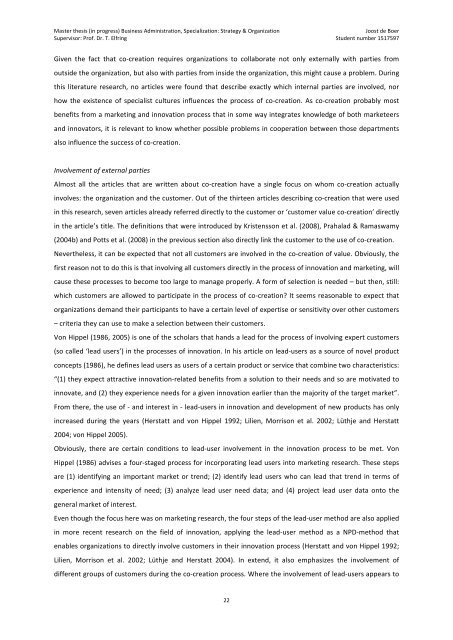Download PDF (English) - Future Ideas
Download PDF (English) - Future Ideas
Download PDF (English) - Future Ideas
Create successful ePaper yourself
Turn your PDF publications into a flip-book with our unique Google optimized e-Paper software.
Master thesis (in progress) Business Administration, Specialization: Strategy & Organization <br />
Supervisor: Prof. Dr. T. Elfring <br />
Joost de Boer <br />
Student number 1517597 <br />
Given the fact that co-‐creation requires organizations to collaborate not only externally with parties from <br />
outside the organization, but also with parties from inside the organization, this might cause a problem. During <br />
this literature research, no articles were found that describe exactly which internal parties are involved, nor <br />
how the existence of specialist cultures influences the process of co-‐creation. As co-‐creation probably most <br />
benefits from a marketing and innovation process that in some way integrates knowledge of both marketeers <br />
and innovators, it is relevant to know whether possible problems in cooperation between those departments <br />
also influence the success of co-‐creation. <br />
Involvement of external parties <br />
Almost all the articles that are written about co-‐creation have a single focus on whom co-‐creation actually <br />
involves: the organization and the customer. Out of the thirteen articles describing co-‐creation that were used <br />
in this research, seven articles already referred directly to the customer or ‘customer value co-‐creation’ directly <br />
in the article’s title. The definitions that were introduced by Kristensson et al. (2008), Prahalad & Ramaswamy <br />
(2004b) and Potts et al. (2008) in the previous section also directly link the customer to the use of co-‐creation. <br />
Nevertheless, it can be expected that not all customers are involved in the co-‐creation of value. Obviously, the <br />
first reason not to do this is that involving all customers directly in the process of innovation and marketing, will <br />
cause these processes to become too large to manage properly. A form of selection is needed – but then, still: <br />
which customers are allowed to participate in the process of co-‐creation? It seems reasonable to expect that <br />
organizations demand their participants to have a certain level of expertise or sensitivity over other customers <br />
– criteria they can use to make a selection between their customers. <br />
Von Hippel (1986, 2005) is one of the scholars that hands a lead for the process of involving expert customers <br />
(so called ‘lead users’) in the processes of innovation. In his article on lead-‐users as a source of novel product <br />
concepts (1986), he defines lead users as users of a certain product or service that combine two characteristics: <br />
“(1) they expect attractive innovation-‐related benefits from a solution to their needs and so are motivated to <br />
innovate, and (2) they experience needs for a given innovation earlier than the majority of the target market”. <br />
From there, the use of -‐ and interest in -‐ lead-‐users in innovation and development of new products has only <br />
increased during the years (Herstatt and von Hippel 1992; Lilien, Morrison et al. 2002; Lüthje and Herstatt <br />
2004; von Hippel 2005). <br />
Obviously, there are certain conditions to lead-‐user involvement in the innovation process to be met. Von <br />
Hippel (1986) advises a four-‐staged process for incorporating lead users into marketing research. These steps <br />
are (1) identifying an important market or trend; (2) identify lead users who can lead that trend in terms of <br />
experience and intensity of need; (3) analyze lead user need data; and (4) project lead user data onto the <br />
general market of interest. <br />
Even though the focus here was on marketing research, the four steps of the lead-‐user method are also applied <br />
in more recent research on the field of innovation, applying the lead-‐user method as a NPD-‐method that <br />
enables organizations to directly involve customers in their innovation process (Herstatt and von Hippel 1992; <br />
Lilien, Morrison et al. 2002; Lüthje and Herstatt 2004). In extend, it also emphasizes the involvement of <br />
different groups of customers during the co-‐creation process. Where the involvement of lead-‐users appears to <br />
22





